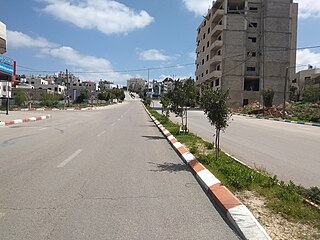March 2020
2 March: The government of the Kurdistan Region in Iraq, ordered the complete closure of the Semalka Border Crossing at the Iraq-Syria border into the Kurdish-led Autonomous Administration of North and East Syria until further notice as "a precautionary measure to prevent the transmission of the coronavirus to the areas of autonomous administration of North and East Syria, excluding emergency cases". [14]
10 March: The Syrian Observatory for Human Rights reported that there have been outbreaks of COVID-19 in Tartus, Damascus, Homs and Latakia provinces. According to the UK-based monitor's sources, a strict gag order has been issued to forbid medical personnel from discussing the issue. [15]
11 March: A health official from the Jazira Region in the Autonomous Administration of North and East Syria said that there are no documented cases of Covid-19 in the province. Kurdistan TV reported from Qamishli, the largest Kurdish city in Syria, stating that 1% of the population in the city are wearing protective masks, as pharmacies and medical equipment sales centers were running low on the supply of masks. Furthermore, by 11 March, four suspected cases of Covid-19 had been reported to the Syrian Health Authority, which contacted the World Health Organization. The tests came back as negative. [16]
14 March: The Pakistani Chief Minister of Sindh province alleged that nationals returning from the Middle East had imported the disease. [4] Out of 14 confirmed cases in Sindh province, eight had a travel history that included Syria. [4] The day earlier, World Health Organization said that all Pakistani cases were imported, but without mentioning the exact origin of those. [4] The Syrian government denied any cases of COVID-19 in the country. [2] Nevertheless, authorities delayed upcoming parliamentary elections, shut down schools, and canceled most public events to prevent any spread of the coronavirus. [2] The Kurdish-led Autonomous Administration of North and East Syria canceled all gatherings, limited entry to the region to residents only on Tuesdays of each week and closed all schools, universities and educational institutes until further notice. [5]
19 March: The Kurdish-led Autonomous Administration of North and East Syria imposed a curfew starting from March 23 at 06:00 am and prohibited movement among the subregions of northeastern Syria, as well as among the major cities within each region starting from March 21 at 06:00. Restaurants, cafes, commercial centers, bazaars, public parks, private medical clinics, wedding halls and mourning tents are to be closed while hospitals, public and private health centers, international organizations, the Red Cross and Crescent, pharmacies, sterilization committees, cleaners, bakeries, food stores, food and baby milk trucks and fuel tanks were excluded from the ban. [6]
20 March The Damascus Governorate and the Syrian Arab Red Crescent begins disinfection of the Yusuf al-Azma Square and other areas of Damascus. [17]
22 March: The Health Minister of Syria reported the first case in Syria. [3]
24 March: The Ministry of Interior declared a curfew from 6 PM to 6 AM, effective starting next day (Wednesday, 25 March) [18]
25 March: The Ministry of Health reported three new cases. The three new cases were among those quarantined in the Dwair center after being abroad. Later that day, around 19:00 local time, one new case was reported. [19]
27 March: The government declared that commuting of citizens between province centers and all other urban and rural areas is disallowed at all times excluding those with clearance, starting Sunday March 29 at 2 p.m. local time. [20]
A 53-year-old man was admitted to hospital in the government-held part of Qamishli in northeast Syria. [21] He was tested for coronavirus and the test was sent to Damascus for analysis. [22] See April 2.
29 March: The Ministry of Health said that a woman has died just after she arrived in hospital, they did a test and the results came positive. [23] Later that day, four new cases were registered. [23]
30 March: The Ministry of Health said that a new person has died. [24]
April 2020
2 April: The Ministry of Health declares 6 new cases. [25]
The man in Qamishli dies of coronavirus the same day his test results come back positive. The man had no travel history outside the country. [22]
4 April: The Ministry of Health announced that two coronavirus cases out of the remaining active 12 registered in Syria have recovered. [26]
5 April: The Ministry of Health announced three new cases. [27]
7 April: The Ministry of Health announced the recovery of a third case. [28]
8 April: The Ministry of Health announced the recovery of a fourth case. [29]
11 April: The Ministry of Health announced 6 new cases and the recovery of a fifth case. [30]
14 April: The Ministry of Health announced 4 new cases. [31]
15 April: The Ministry of Health announced another 4 new cases. [32]
17 April: The Ministry of Health announced 5 new cases. [33] Rojava announced its first case. [34]
19 April: The Ministry of Health announced one more death and one more case. [35]
21 April: The Ministry of Health announced one recovery [36] and three new cases. [37]
25 April: The Ministry of Health announced 5 new recoveries. [38]
26 April: The Ministry of Health announced 3 recoveries and one new case. [39]
27 April: The Ministry of Health announced 5 new recoveries. [40]
28 April: The Ministry of Health announced 2 new recoveries. [41]










